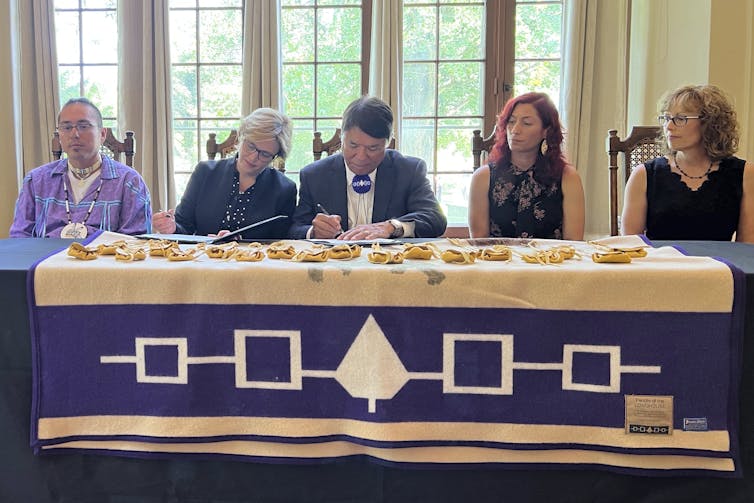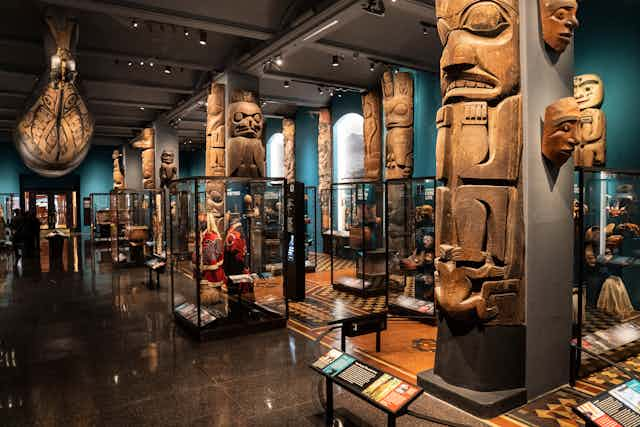A new amendment to the United States’ Native American Graves Protection and Repatriation Act (NAGPRA) came into effect in January 2024. The amended law now has some teeth to penalize museums who have thus far been very slow to engage with Indigenous communities. It puts pressure on them to create and share inventories of the remains and artifacts they hold.
NAGPRA regulates the repatriation of Native American human remains, funerary and sacred objects, and objects of cultural patrimony from federally funded agencies to lineal descendants, Indian Tribes and Native Hawaiian Organizations.
Museums must now get prior and informed consent from Indigenous communities before displaying and studying cultural objects. They must also incorporate Native American traditional knowledge in the storage, treatment and handling of remains and cultural items. The act now gives museums and other federal agencies five years to “consult and update inventories of human remains and associated funerary objects.”
NAGPRA is an important step in a long history of Indigenous Peoples’ struggle to govern their heritage. However, its authority stops at the U.S. border.
We are First Nations historians and professors working in Canada. Our communities are also impacted by the loss of cultural patrimony to museums in the U.S. and the laws covering repatriation. Mary Jane Logan McCallum is a member of the Munsee Delaware Nation and Susan M. Hill is a Haudenosaunee citizen and resident of the Grand River Territory.
The U.S. law provides Indigenous communities in lands claimed by Canada no legal or financial support to repatriate human remains, funerary and sacred objects and objects of cultural patrimony held in U.S museums. These institutions hold many items purchased or obtained by anthropologists and others from communities north of the border.

NAGPRA
NAGPRA became law in 1990, after decades of lobbying from hundreds of Indigenous communities. The law states that museums and institutions receiving federal funding must produce detailed inventories of their collections and notify Native American tribes regarding items connected to their communities.
While those who called for the legislation were undoubtedly aware of the daunting task it would mandate, it is unlikely any would have predicted the extremely slow pace at which it has progressed in the three decades since.
Unfortunately, some museums have unilaterally decided to cover or close displays. This is intended as a first step towards repatriation, however with ongoing limited resources, it is also a tactic to remain compliant with the law and avoid having funding cut.
The newly revised law still upholds inherent inequities in the relationships between Indigenous people and the agencies holding our materials. There is a lack of consistent and adequate funding for Indigenous communities wishing to repatriate items. There is also a lack of expert knowledge of the holdings of museums across the U.S. and human resources and infrastructure for long-term handling of repatriated objects.
In this context of ongoing inequity, museums can continue to hold Indigenous objects, but away from public view, and inadvertently create a narrative of history centred on white stories and white voices with little or no Indigenous content.
Indigenous communities outside the U.S.
For Indigenous communities outside of the U.S., the act does not compel museums and institutions to work in good faith to facilitate repatriations, regardless of how much evidence Indigenous communities are able to provide supporting the origins and sacredness of those items.
Indigenous communities in Canada are impacted by the law because these items are important to community-based research of material culture and its connection to intellectual, social and political histories of our nations.

Museums make platitudes about strong commitments to working with and educating about Indigenous Peoples and cultures. However, they are still the ones choosing what gets displayed without consultation with Indigenous communities. Meanwhile, the burden is placed on tribes to make requests and pay for repatriation.
As a result, the public loses important opportunities to learn about Indigenous Peoples and the colonial legacies that dispossessed them of the land upon which museums are built and the artifacts they house.
Indigenous labour
A further issue with NAGPRA is that it perpetuates an assumption that Indigenous labour should be discounted or free and reasserts the inequity faced by Indigenous people when dealing with government.
Small, piecemeal grants covering costs like transportation are available through NAGPRA, but are restricted to federally recognized tribes in the U.S. and Indigenous people are responsible for finding and applying for them.
In Canada, community-based Indigenous scholars can apply for federal funding from the Social Sciences and Humanities Research Council of Canada, however grant applications can be long and difficult, funds received are administered by universities and the grants often do not provide enough money.
Museums have full-time paid staff to make inventories and seek descendant individuals and communities. On the other hand, the Indigenous labour, knowledge and skill that goes into identifying and making meaning of lost cultural patrimony, often goes unpaid and unappreciated.

In addition, those doing this hard work contend with the anti-Indigenous racism and white supremacy that dominate museums and other cultural institutions. Some museums have prioritized hiring Indigenous staff, but they have not made structural changes that address ongoing systemic racism and colonialism nor made space for Indigenous people. As a result, several have left or resigned in protest.
In 2022, the Canadian Museums Association delivered a report that acknowledged Indigenous cultural heritage professionals are often required to work for free or at a very low cost through one-off honorariums. It recommended that museums take on the legal and financial responsibility of new positions for those undertaking this work. We have yet to see this in practice.
The new U.S. regulations still do not address another form of theft from Indigenous people — this time not of Indigenous cultural patrimony, but of Indigenous labour. This should be considered by the Office of the Independent Special Interlocutor for Missing Children and Unmarked Graves and Burial Sites associated with Indian Residential Schools as it considers a new federal legal framework that will govern the treatment of graves and burial sites.

